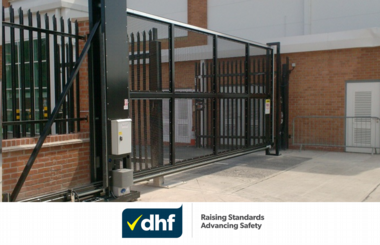
DHF’s Senior Training & Compliance Officer, Nick Perkins, explains more about the recently harmonised European standard, EN 12453, and what this formal listing means with regards to levels of safety for manually operated doors, gates and barriers.
The European Standard, EN 12453:2017+A1:2021, pertaining to mechanical requirements and test methods for vehicle and goods gates and barriers, has now been harmonised under the Machinery Directive (MD) in the EU; listing as a designated standard in the UK is now merely a formality.
“This is considered a particularly significant moment in a narrative that has been on-going since 2011 when UK HSE issued a formal objection to the original 2000 version,” explains Nick. “In response to this, the European Commission listed the standard with a warning not to rely on it entirely for legal compliance; since Brexit, this has been mirrored in HM Government’s listing of designated standards for machinery.”
The recent formal listing as harmonised with MD, without a warning, ends eight years of comparative doubt about what the legal minimum level of safety is. Formal harmonisation with MD (and hence the UK Supply of Machinery Safety Regulations also) has two effects. Firstly, it defines the state-of-the-art for complying with the essential health and safety requirements of the Regulations/MD, and secondly, it enables responsible companies to declare conformity with the Regulations/MD by declaring full compliance with the standard. In legal terms, it outlines the minimum level of safety for all systems within its scope, regardless of where they are installed or who uses them.
With regards to practicality, compliance will now require that gates and barriers cannot derail or fall over due to single fault failures, that gates and barriers will be electrically safe and be controlled by safety systems that only fail to safe, and that all accessible gaps and impact points must be protected to prevent injury to people or body parts. Essentially, the gate or barrier will either stop and reverse on contact within defined force and time limits, or not make contact with the person or any body part.
“Where people or body parts can be compressed against something, the maximum force is 400N, reducing back to 150N within 0.75 of a second, further reducing to 25N within five seconds,” continues Nick. “Where people can be impacted but not crushed, the maximum is raised to 1400N but with the same 150N, 0.75 second, 25N and five-second maximum as for crush, shear and draw-in points. These constraints do not just apply at the main edge, but all areas where contact can occur must be protected. In addition, where contact can occur in the closing range of the gate, the force and time limits must be supplemented with low level non-contact devices to reduce the probability of contact. Non-contact devices used to supplement force limitation should not be confused with non-contact devices that can be used without force limitation. Full non-contact protection without force limitation is a much higher requirement that must be active over the full height and width of movement, and throughout the entire movement area; this is commonly achieved with light grids or laser scanners. However, this is very difficult to achieve with hinged and folding gate systems.”
As mentioned above, this represents the minimum safety for all systems, regardless of where they are installed, or who will use them, and is dealt with by compliance assessment on a pass/fail basis. To ensure that the needs of individual systems and sites are fully protected, the installation process must also include a residual risk assessment that assesses the degree of harm, the frequency of exposure, the likelihood of exposure and the nature of the users.
“This is genuine risk assessment,” concludes Nick. “It will define what, if any, additional measures are necessary. Appropriate residual controls can include one or more of: lower force, additional non-contact devices, signage, markings, vehicle detectors, traffic control and many more passive strategies for reducing risk. As the standard only deals with the safety of people, vehicle safety must also be dealt with at this residual stage. “
Full details on compliance are in DHF TS 013-1 onsite guide –https://bit.ly/DHFTechnicalSpecifications
Compliance, safety & residual risk assessment training for gates and barriers is available here – https://bit.ly/43Qh4N1
January 2024
Join dhf
Enjoy the full benefits of dhf membership
Apply today